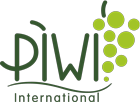Author: Jiri Sedlo
Members of the "PIWI International" association from Germany, Austria, the Czech Republic, Switzerland, Italy, Poland and the Netherlands met in Neustadt an der Weinstrasse for the annual general meeting. Most of them are winemakers who grow (sometimes exclusively) PIWI grape varieties.
A board meeting of the organization was held on Friday morning, followed by a visit to Rebschule Freytag, which is one of the main suppliers of these resistant grape varieties, giving participants an insight into their work and interesting information about breeding and propagation (Figure 1).
Figure 1: Volker Freytag (left) at a presentation on his farm
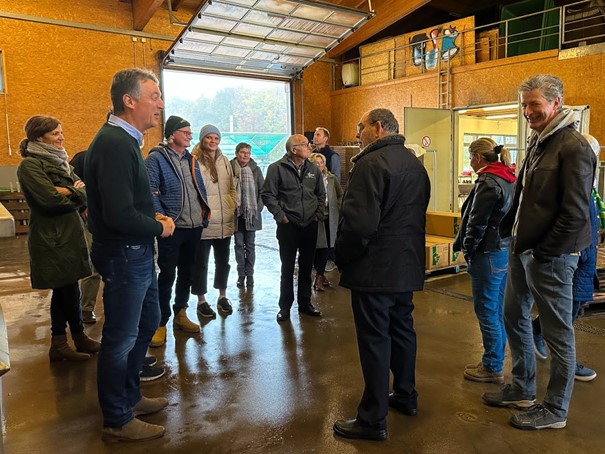
The motto of the afternoon at the “Neustadt Wine Campus” at the Ludwigshafen University of Applied Sciences was “Science meets practice”. Four specialist lectures highlighted the spectrum from breeding to wine sales, here is a brief summary:
- Research on the economic sustainability of companies and PIWI varieties: Surprising findings and perspectives (Prof. Dr. Marc Dressler, Weincampus Neustadt)
A very interesting lecture with lots of data: more than eight years ago, the German winegrowers rated the PIWI varieties in tenth place in terms of their contribution to ecology on various criteria, e.g. water, energy, greenhouse gases, fertilization, soil care... Less soil compaction and less Pesticides were wanted, but not the PIWI varieties. Today the situation is different, in selected German supermarkets wines made from PIWI varieties are sold at prices between 5 and 9 €/0.75 l. On the German market, wines made from PIWI varieties are now sold for an average of €9.53/bottle (n = 1119), which corresponds to the most common price range of €5 to €8 (over 40 %), followed by a range of €8 to 10 € (over 25 %). 78 % of the wines are sold as varietal wine, 12 % as PIWI cuvée and 10 % as PIWI + classic varietal cuvée.
This is reflected in the current interest of winemakers in the PIWI varieties. Only 40 % of the farmers are not interested in growing them, 21 % plan to grow them and 39 % are already planting them. Organic farmers are more interested in them. Of the farms that are already growing them, 60 % want to increase their acreage and only 6 % want to decrease their acreage (mostly those only growing the Regent variety). There is a growing number of PIWI products, manufacturers and varieties on the market.
For the Pinot blanc and Calardis blanc varieties on organic farms, a comparison was made between the costs for vine protection and the grape yield. For Pinot blanc and Calardis blanc, the average protection costs were €944/ha and €435/ha, respectively, while the grape yield for CB was 2.7 times higher.
– Reduced protection of PIWI grape varieties (Prof. Dr. Jochen Bogs, Weincampus Neustadt)
The presentation focused on the molecular mechanisms of resistance and explained which genes are responsible for resistance to downy mildew and powdery mildew of the vine. Prof. Bogs pointed out that there are also differences in the resistance of the different PIWI varieties, e.g. Regent has one resistance locus, Sauvignac has two, while Müller Thurgau has none. This is then reflected in the resilience of the vines. It is also important how quickly the plant recognizes the attack of the pathogen; this uses different types and numbers of receptors within each resistance locus, so that resistance is not determined solely by the number of resistance loci.
The actual number of treatments with a particular PIWI variety depends on the infection pressure. In the 2021 trial, a year of extremely high mildew pressure in Germany, the tested PIWI varieties needed 0-4 treatments, while the conventional varieties needed 14 treatments to achieve the same result. The speaker pointed out that the complete waiver of protection for PIWI varieties leads to a loss of resistance and therefore does not make sense in practice.
- Knowledge transfer to PIWI varieties as part of the school project week "Sustainable Viticulture" (Karin Franzen, Institute for Viticulture and Oenology, DLR Rheinpfalz)
Ms. Franzen presented the educational project for DLR students, which is a follow-up project to the VITIFIT project and is intended to prepare the younger generation for sustainable viticulture.
– Stylistics of the PIWI wine varieties: consumer and expert preferences, including a comparative tasting (Prof. Dr. Ulrich Fischer et al., DLR Institute for Viticulture and Oenology Rheinpfalz)
As part of the VITIFIT program, consumer studies are carried out, the most suitable winemaking methods are examined, the wine is described in detail and selected aromatic substances are analyzed. In a practical lecture, Prof. Fischer focused on the description and comparison of the different winemaking methods of the PIWI varieties whose samples were tasted. Calardis blanc, for example, was processed into a sparkling wine similar to Pinot Blanc or Riesling with a yield of 19 t/ha. The Cabernet blanc, on the other hand, yielded 20 t/ha in 2021 and 14 t/ha in the two previous years, with the average sugar content in these three years being between 85-100 degrees Oe".
Consumers evaluate wines made from PIWI varieties in the same way as wines made from traditional varieties, i.e. in closed tastings. German consumers also prefer the fruitiness, sweetness, body, tropical fruits and floral aromas of the PIWI varieties. In addition, three differently vinified samples of Laurot were presented. Prof. Fischer (Figure 2) concluded that the potential of the PIWI varieties in terms of the necessary changes towards more sustainability is enormous. And you no longer have to hide from comparing the taste of PIWI wines with traditional varieties.
Fig. 2: Prof. Dr. Ulrich Fischer during his lecture
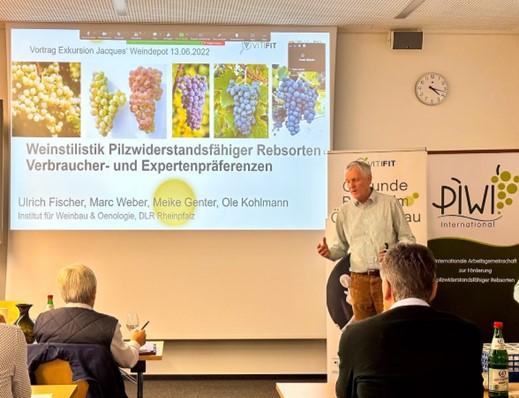
At the annual general meeting on Saturday (Figure 3), which also took place online, President Alexander Morandell (I) reported on the numerous activities of the association over the past year; the board itself met 14 times online and once physically, traditionally in Prien (D). The most important activities of the association included the new format of the PIWI International Wine Challenge and the drafting of the new statutes of the organization. This should enable PIWI International to act as an umbrella organization for the national associations.
Fig. 3: Some of the participants at the General Assembly on November 12, 2022
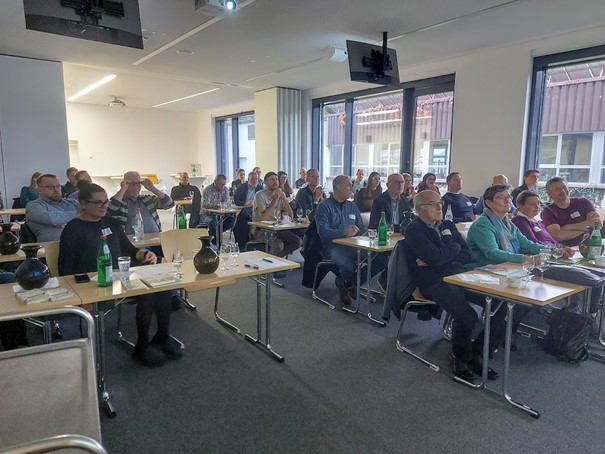
The annual general meeting confirmed the current board members in their positions at the election. Only former President Josef Engelhart (D) resigned from the Executive Board at his own request after several terms in office. Current President Alexander Morandell thanked him for his many years of service to PIWI International. He remains available for advice in his specialty, the cultivation of PIWI grape varieties. His place in this body was taken by Heinrich Leutenberger (D), who took over the office of the minute-taker. Auditor Edwin Locher was confirmed in office and Ulrich Frizlen was unanimously elected second auditor.
A lively debate ensued about the use of the PIWI International logo, which should be strengthened as a brand and also used more frequently by the members:
Following the AGM, Dr. Oliver Trapp presents the theory and practice of the PIWI varieties that have been bred at the Julius Kühn Institute (JKI) in Geilweilerhof over the last few decades (Figure 4).
Figure 4: Dr Oliver Trapp from the JKI gives a lecture
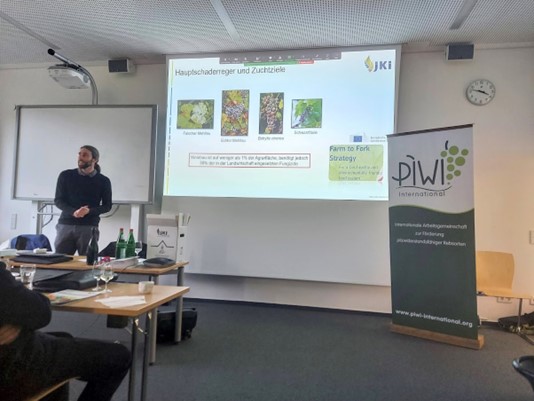
The very knowledgeable talk on resistance breeding in grapevines also included an interesting general introduction where he gave some data:
German viticulture is not even operated on the entire 1 % of agricultural land, but consumes 30 % of the fungicides used in agriculture. This means that hardier vines need to be grown. New varieties are also needed in view of climate change. In Germany, between 1990 and 2019 there were 28 years with above-average temperatures (compared to the 1961-1990 average) and only 2 years with slightly below-average temperatures (1996 and 2010). This leads to an earlier onset of each phenophase, followed by spring frost damage and sunstroke. The acidity of the wines of the traditional varieties also decreases.
In Germany, 36 PIWI varieties are currently entered in the variety register and a further 40 PIWI varieties are approved for cultivation. In total (2021) they are cultivated on 3 283 ha, which corresponds to about 3 % of the area under vines. The annual increase in PIWI varieties is not very dynamic, but old PIWI varieties are being replaced by new ones. Regent, for example, occupied 2,100 ha in 2005 and only 1,600 ha in 2021. Seedlings of PIWI varieties are no longer available in Germany for sowing in 2023.
In recent years, the JKI has been collaborating with the INRAe Colmar. This cooperation has resulted in new varieties with higher resistance (Artaban and Vidoc) for southern France, which are now being tested for their suitability for Germany.
After the second half of the lecture, a guided tasting of the PIWI varieties bred at the Geilweilerhof took place. The PIWI varieties Villaris, Felicia, Calardis blanc, Calardis Musqué, Calandro and the promising crosses Gf.2010-011-0048 and Gf.2004-043-0010 were presented and described one after the other.
After dinner there was an opportunity to present the winners of the International PIWI Wine Competition with their diplomas and to taste a number of excellent wines. The winning producers and all the results are listed on the website
https://piwi-international.org/piwi-international-wine-challenge-2022/.
On Sunday morning the event ended with a visit to the Mohr-Gutting winery in Neustadt-Duttweiler (Figure 5). Here the participants were introduced to an organic winery that has been working with PIWI varieties for years.
Figure 5: Presentation by the owner at the Mohr-Gutting winery in Neustadt-Duttweiler
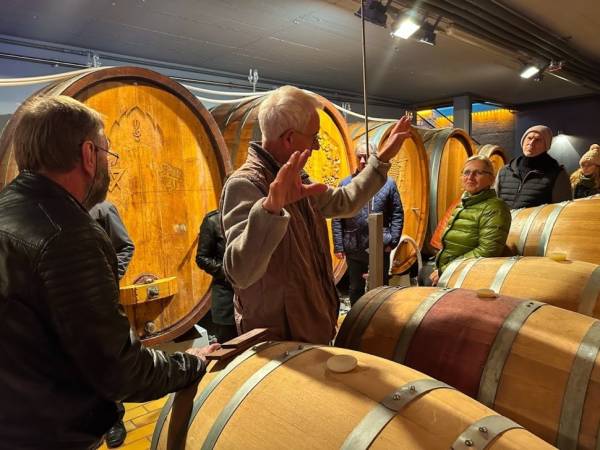
Today, PIWI International is a strong international network that is not only represented in the traditional European wine-growing countries, but is also expanding in Denmark, England, Sweden and even Norway, as well as in the USA and Canada.
Edited by Jiří Sedlo, photos PIWI International Archive
